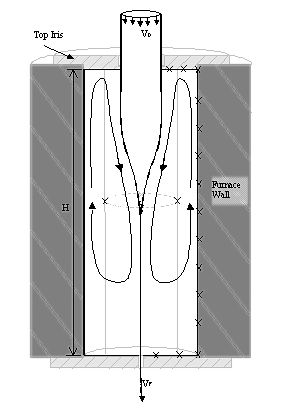Polymer Optical Fiber Manufacturing - Heating Instabilities
- Overview
- Preform Heating
- Fiber Drawing
- Heating Instabilities

During fiber drawing the furnace wall is typically hotter
than the top iris. This temperature difference promotes air circulation as
hot air next to the wall rises while the cold air next to the top iris
sinks. Researchers investigating natural convection flow
in tall annular enclosures have shown that as the intensity of this
buoyant circulation is increased the convective flow can become unstable.
Steady unicellular flow can transition to oscillatory multicellular flow,
through a supercritical Hopf bifurcation. Other phenomena common in the
field of chaos theory have been observed, such as period doubling,
multiple solutions, intermittency, and quasi-periodic and fully chaotic
flow.
Experiments in our lab have confirmed that convective instabilities can
occur during fiber drawing. More importantly these variations can cause
significant and detrimental variation in the fiber diameter. This is the
first time convective instabilities and their impact have been identified
in the fiber drawing process.
Time-Variant Heating
The figure below shows the furnace air
temperature histories recorded as the temperature of the top iris was
decreased. When the top
iris is hot the air circulation within the furnace is laminar and the
recorded air temperature is constant (as shown in the top temperature
history below, a). When the top iris
temperature is decreased (thus increasing the buoyant potential) the flow becomes
unstable and the recorded air temperature starts to oscillate with a
frequency of 0.23 Hz (see the middle plot, b). As the temperature of the top iris is
further reduced the flow suddenly becomes chaotic with variations in
temperature of up to 3 C (see the bottom plot below, c).

The frequency of the oscillations was found to be a
function of the temperature difference between the furnace wall and the
top iris. This behavior is consistent with prior investigations.
Effect on Fiber Diameter
The time-dependent heating caused by the oscillatory and
chaotic regimes alters the rheology of the elongating polymer preform,
causing detrimental time-dependent variations in the fiber diameter.

The figure above shows the fiber diameter histories
corresponding to the laminar,
oscillatory, and chaotic flow regimes discussed above. The standard
deviation of the fiber diameter under laminar heating conditions
is 0.6 microns. The diameter variation increases significantly for
the oscillatory and chaotic heating regimes with
standard deviations of 1.5 and 6.9 microns, respectively.
A transparent model of the fiber drawing furnace was constructed that
allowed optical access to the convective flow instabilities that had
been measured during fiber drawing. In this model a quenched PMMA preform
was used to create the curved inner geometry. Seed particles were
illuminated with a vertical laser sheet (see figure below left). This
allowed a two dimensional vector plot of the natural convection to be
created (below right).

Interrogation of the axial velocity measured near the
interface between two convective cells (marked with a white cross in the
figure located above right) shows that the flow oscillates in a periodic
fashion (see below). An animation (1.2Mb avi file) shows the oscillation in the
vector field for the time duration shown below.
